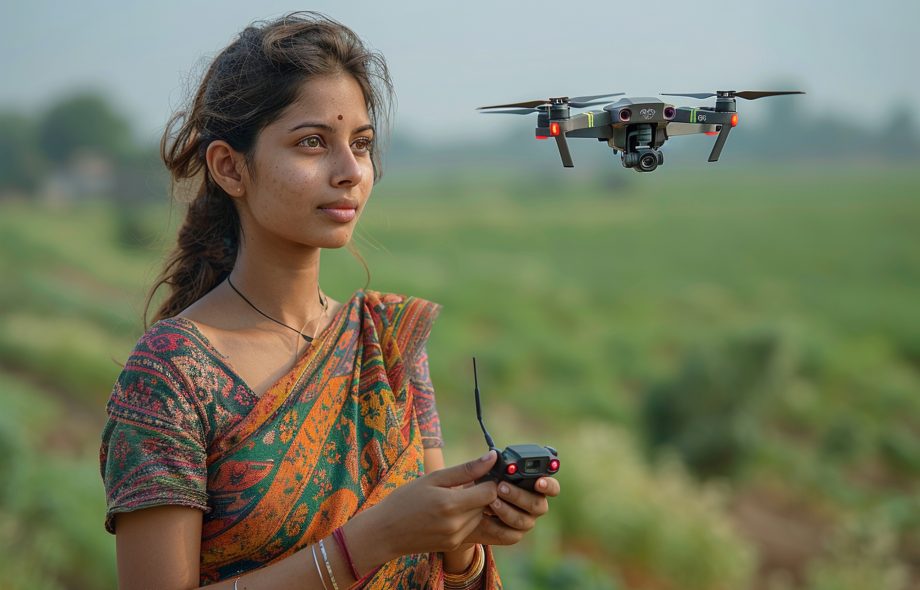For decades, agriculture has been one of the most male-dominated industries in India. From tilling the soil to driving tractors, the image of farming has long been associated with men. But the winds of change are blowing — and this time, it’s from above.
Women are taking control of drones across villages and small towns by spraying crops, mapping fields, and reducing the risks of traditional farming. What seemed impossible earlier is becoming a reality faster—rural women flying drones. This change not only leads to the acquisition of a new skill but also involves breaking barriers, fostering freedom, and proving that the future of farming belongs not only to men but to everyone.
The Rise of Women in Drone Technology
Drones are already revolutionizing agriculture; they are no longer merely futuristic instruments. They are improving farming efficiency, sustainability, and safety through methods such as crop spraying and aerial surveys. Drone piloting is a skill-based occupation as opposed to traditional farm work, which involves strenuous physical labor. This gives women who would have previously been excluded a special opportunity.
For women, the rise of drone technology means three things:
-Economic empowerment — steady work and financial independence.
-Community inspiration — showing young girls that farming is open to them, too.
-Changing perceptions — proving that machines are not just “men’s work.”
“And nowhere is this more visible than in the story of the Drone Didis — a group of women who are showing how technology can transform not just farming, but lives.”
A New Kind of Farming Revolution
For generations, farming in India has been synonymous with long hours under the sun, carrying heavy loads, and relying on age-old practices. However, in the fields of Varanasi, a quiet revolution is underway. The ones leading it are not scientists or corporate executives, but a group of women known as the “Drone Didis.”
The Drone Didis are nine women who have been trained at drone academies to become certified pilots under government-backed initiatives. Most of them come from farming families where work was traditionally divided along gender lines: men worked in the fields, while women managed households.
Today, the picture is very different. Each of these women is a certified drone pilot, capable of operating agricultural drones with precision and skill. These women are rewriting the story of agriculture by flying drones over fields, spraying fertilizers, mapping crops, and making farming more innovative, safer, and more efficient.
Achievements on the Ground (and in the Sky)
These women are not just learning — they are achieving milestones that once seemed far out of reach. With drones in their hands, they have covered thousands of acres of farmland, completing spraying tasks in minutes that would otherwise take hours of exhausting manual labor. This efficiency has evolved into a steady livelihood, providing families with financial stability while establishing a new model for sustainable rural income.
Beyond financial gain, their work has made farming more efficient. Farmers can conserve water, reduce labor expenses, and use fewer chemicals by employing drones for precision spraying, making agriculture safer and more sustainable. Communities’ perceptions of these women have also altered as a result of their accomplishments; they are no longer restricted to conventional jobs and are proud to be pilots, a term that was previously unthinkable in rural areas. As women take the lead in the transition to modern farming, this change provides financial stability for their families and a renewed sense of pride for their villages.
Challenges They Faced
The journey of becoming drone pilots was not without struggles. Many women had to overcome the social stereotype that characterized machines as “men’s job,” and some encountered opposition from relatives who questioned whether operating drones could ever be a legitimate career. For women from isolated communities in particular, financial constraints and the distance to training facilities created additional challenges. Initially, it was frightening for people who were not tech-savvy to handle drones. Issues still persist, ranging from societal hurdles in specific communities to a lack of awareness and access to training. Nonetheless, the advancements made thus far demonstrate that, with the correct resources and instruction, women can not only embrace technology but also turn it into a tool for their own empowerment.
The story of women drone pilots in India is more than an agricultural innovation — it’s a social movement. The future of farming is bright and inclusive, reflecting the true strength of rural India — resilience, adaptability, and courage. These women are not just flying drones — they are lifting entire communities with them. As more people take to the skies, the future of Indian agriculture looks not only more innovative, but also braver and more inclusive.
 :
https://in.pinterest.com/OfficialAVPL/_profile/
:
https://in.pinterest.com/OfficialAVPL/_profile/

